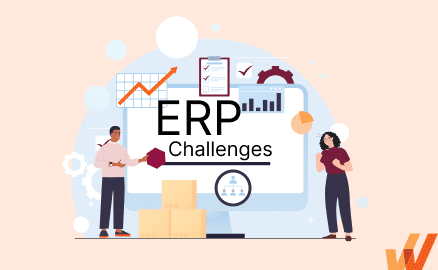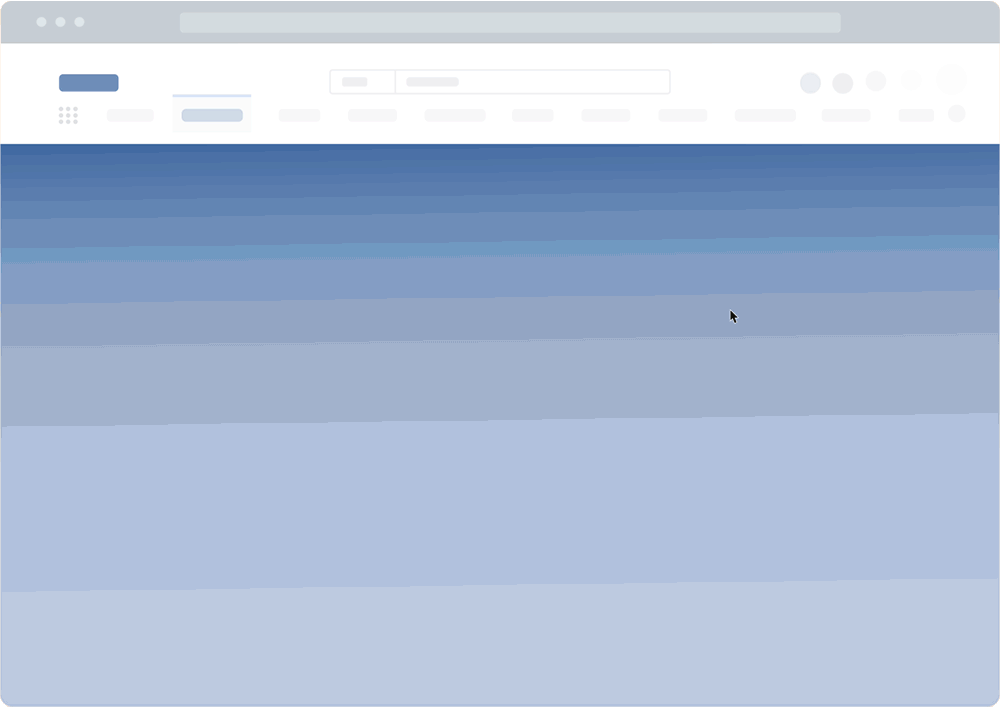
An ERP implementation is expensive, and understandably so, because of its value proposition. They serve as a single source of truth where enterprises can manage and automate their entire business processes.
Yet, for all it costs, only a shocking 26% of employees report using their company’s ERP.
Maybe, it’s because ERPs have a steep learning curve, or because 51% of companies experience operational disruptions when they go live with an ERP. As a result, it’s easy for employees to carry on as usual instead of making a new ERP part of their daily workflow – leading to a failed ERP implementation that disrupts employee productivity, hurts trust in leadership, and has a huge cost impact.
6 tips for improving your ERP adoption
- Include your end-users in the adoption planning process
- Invest in a digital adoption platform (DAP) for onboarding and training
- Personalize your ERP experience
- Provide on-demand support for your ERP users
- Monitor adoption rates of various ERP features to identify training needs
- Highlight early ERP adoption wins and process improvements

Abby Essing, Sr. Manager, Operations Services at Renewable Energy Group, Inc.
5 ERP Adoption Challenges to Overcome
None of those challenges invalidate the fact that ERPs help growing businesses to:
- Save on expenses
- Streamline processes
- Reduce repetitive manual work with automation
According to a 2018 report by Hubspot, 95% of businesses that adopt an ERP record improved performance with their processes. Another study shows that 82% of enterprises that switch to ERPs achieve a positive ROI on schedule, on average, within 2.5 years.
If you want to record similar results, we need to isolate the challenges companies face with scaling adoption across the entire organization and figure out how to tackle them.
1. Lack of an implementation and adoption strategy
An implementation plan is how an organization intends to start using an ERP as part of its day-to-day workflow. It considers the company’s size, goals, priorities, and timelines to determine how to roll out an ERP transformation, who should work on it, and which process and features to build out.
An adoption strategy is a plan for getting a company’s employees to switch to using an ERP as their daily driver, from whatever they’d been using previously.
Sadly, large enterprises often don’t take all these variables to mind and they try to start using an ERP like a done-for-you B2C SaaS product (like Notion or Todoist) right off the shelf —no wonder 50% of ERP implementations fail at first and the majority exceed budget by up to 300%
2. Compliance-related issues
An ERP provider should adhere to local and federal regulatory standards on accounting, taxation, and privacy. This means their platform should be certified for HIPAA, GDPR, GAAP, and any applicable standards that apply in your industry or geography. If not, your business could run into issues with handling your customers’ data, privacy regulations, etc.
3. Onboarding and training
Months after an ERP deployment, businesses often find that their employees aren’t engaging with the ERP’s capabilities as expected —those who do engage with it struggle to do so and prefer to use the old tools they’re familiar with.
When businesses think about ERP onboarding and training, they often book a few webinars and 1:1 sessions with their implementation partners and magically expect their employees to become conversant with the new systems in a few weeks —and surprise, they don’t.
4. Internal resistance from employees
Often, employees are convinced their existing tools are better than whatever an ERP offers that they don’t bother trying it out and resist change. Or maybe they still have aggressive targets, and they can’t afford to go through a learning curve where their productivity takes a hit.
5. Tracking end-user adoption
Onboarding, training, and adoption feedback are the three parts of a flywheel you need to master to boost adoption for your ERP. If employees get the training they need, they’re more likely to embrace a new ERP.
And when you collect their feedback and use it to refine your training programs and customize your ERP, you end up with a positive loop where adoption and productivity grow together. But if any of those are lacking, your end-users won’t be as eager to adopt an ERP when they don’t believe it’ll make them more efficient.
How to Improve Your ERP User Adoption
For all the benefits an ERP offers, you can only get them if you can get to critical mass, i.e. when a significant percentage of your organization uses it daily within their teams and across departments.
This, in turn, creates a network effect and makes it easier for large organizations to communicate inside an ERP and automate repetitive tasks from one source of truth.
1. Include your end-users in the adoption planning process
Your end-users will help you determine an adoption strategy that will help them get invested into an ERP faster, vs. dictating policies from a group of disconnected executives. Engaging your end-users will help you determine variables and metrics such as:
- What channels are we going to leverage for our adoption efforts, i.e. videos, text content, 1:1 coaching, team-wide conversations, webinars, etc.?
- How long should our adoption timeline be, and what are our targeted adoption rates for each phase?
- What metrics should we use to measure how quickly we embrace the new ERP?
Your end-users will help you understand any issues they have with your new ERP (to help you figure out the ideal adoption strategy), how you can shorten the technology adoption curve, and which channels will help them learn faster.
2. Invest in a digital adoption platform (DAP) for onboarding and training
A digital adoption platform acts as a layer on another software product (in this case, your ERP) that helps users understand how to use it, navigate its features, resolve issues quickly, and complete their tasks.
A digital adoption platform like Whatfix provides a no-code editor to create contextual, role-based in-app guidance and real-time user support including:
- In-app Tours and Task Lists to familiarize new end-users with your ERP and its core processes and help quickly get your ERP end-users proficient with its UI and core processes.
- Step-by-step Flows that guide end-users through their contextual processes inside your ERP.
- Smart Tips that provide additional process-related information in the flow of work and nudge ERP end-users to take a specific action.
- Pop-Ups that alert employees to company announcements, new compliance laws or regulations, ERP process changes, and more. Attach your Pop-Ups to guided Flows or embed a video to provide additional context.
- Embedded Self Help that provides a resource center inside your ERP’s UI. Self Help connects to your SOPs, training docs, videos, playbooks, FAQs, intranet, third-party links, and more – curating these resources into a searchable self-help wiki on all things related to your ERP and the employees that use it.
- Field Validation that ensures your ERP end-users are entering all required data, in the correct format, keeping ERP data clean and compliant.
- In-app Surveys to gather employee and ERP end-user feedback.

Whatfix is a digital adoption platform that helps drive user adoption and engagement at scale through context-sensitive ERP end-user onboarding, reinforcement training in the flow of work, and real-time support. Create personalized Flows and contextual Smart Tips to speed up the ERP adoption process and enable your end-users.
With a digital adoption platform like Whatfix, enable your employees with in-app guidance and contextual self-help IT support to accelerate the adoption of new software implementations, employee onboarding, change initiates, and more. Whatfix’s no-code editor enables IT teams with a no-code editor to create product tours, interactive walkthroughs, task lists, smart tips, pop-ups, self-help wikis, and more. Analyze and measure user engagement and software usage to identify friction points, measure digital adoption, and improve employee digital experiences.
3. Personalize your ERP experience
An ERP serves as the central nervous system for managing your company’s marketing, procurement, resource management, and sales processes. With everything happening in one source of truth, the data one department needs may be useless to another.
So, your adoption strategy should aim to help individual users cut through the noise and focus on their own work with:
- Role-based workspaces that show users files and tools tailored to their needs
- Responsive design across mobile and web interfaces
- Status dashboards they can use to track specific metrics and KPIs
An ERP might be a single source of truth for your entire organization, but all that data only makes sense when it’s segmented on an individual and departmental basis.

4. Provide on-demand support for your ERP users
ERP providers often provide helplines via phone, email, and live chat. Depending on your company’s size, you can also contact your ERP implementation partner to provide routine maintenance and support.
While both tactics are great, they add another level of complexity to your employees’ workflows. Instead of focusing on their work, employees now have to request support, search through dozens of articles, or wait until your implementation partner’s next scheduled consultation.
With a DAP like Whatfix, enable your employees with ERP end-user support directly inside your ERP’s UI with Self Help – which connects to your ERP-related SOPs, training and onboarding materials, third-party links, videos, and any support-related content to provide a moment-of-need resource center.

Above: Example of contextual help and user support built with a Digital Adoption Platform.
Whatfix’s Self-Help overlays on to any web application, desktop application, mobile app, or website. It provides contextual help to users and integrates with your FAQs, support center, LMS, user documentation, and more. Users are presented with common issues and help content for their contextual area in the application, or they can use an open-ended search to find the specific help content they’re looking for. These help support cards often prompt in-app guidance, walking users through the specific workflow they need help on.
5. Monitor adoption rates of various ERP features to identify training needs
Your adoption rates are the most important metric to measure if your employees are using your new ERP as planned. And if they’re not, you’ll need to circle back to our first point (on engaging employees during the product adoption planning process) to figure out why and how you can smoothen the learning curve and reduce your time-to-value.
With a DAP like Whatfix, analyze your ERP processes and end-user engagement with user behavioral analytics. This enables IT teams to track any end-user event, enable teams to:
- Analyze and create optimal ERP workflows.
- Identify areas of end-user friction.
- Segment ERP end-users into cohorts to create contextual in-app Smart Tips and role-based journeys.
- Monitor ERP license usage and drive end-user adoption.
Analyze user adoption, map journeys and flows, build user cohorts, and identify areas of friction all in Whatfix's no-code event tracking and adoption platform.
With Whatfix’s digital adoption platform and analytics suite, analyze, build, and deliver better end-user experiences to accelerate technology adoption and enable end-users to maximize software usage. Whatfix’s no-code system enables IT teams to analyze and measure digital adoption and product usage, create in-app guidance, and provide self-help user support.
6. Highlight early ERP adoption wins and process improvements
The aim of switching your organization to an ERP is to improve process efficiency, automate manual tasks, and create one source of truth where departments, teams, and even the entire organization can cooperate.
If your end-users are comfortable with whatever tools they’re using, they may not be too eager to make the switch. But if you can show them that your new ERP will make them more productive, it’ll be easier to convince them that:
- Adoption won’t take as long as they imagine
- Your ERP project isn’t a vanity project that will get shelved quietly, i.e., that your new ERP will be the center of a bigger chunk of your organization’s operations
- This new platform will make them more efficient
Whether it’s higher revenue, lower wait times, or faster onboarding, let your ERP sell itself until you can scale adoption to a critical mass of users across your company.
Whatfix acts as a canvas that overlays your ERP and provides contextual guidance to your end-users, driving adoption through in-app guidance and moment-of-need performance support that brings explainer videos, articles, to-do lists, and tips directly into your ERP’s UI. Whatfix’s end-user guidance and support platform shows your role-based resources and provides step-by-step guidance that will help them get started with your new ERP faster at their own pace.
Software clicks better with Whatfix's digital adoption platform
Enable your employees with in-app guidance, self-help support, process changes alerts, pop-ups for department announcements, and field validations to improve data accuracy.
Thank you for subscribing!



